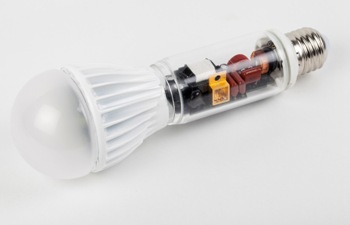LEDs are durable and save energy. Now researchers have found a way to make LED lamps even more compact while supplying more light than commercially available models. The key to success: transistors made of the semiconductor material gallium nitride.
 Gallium nitride transistors enable the compact design of this 2090 lumen retrofit LED lamp (exploded diagram for purpose of illustration). © Fraunhofer IAF
Gallium nitride transistors enable the compact design of this 2090 lumen retrofit LED lamp (exploded diagram for purpose of illustration). © Fraunhofer IAF
Incandescent light bulbs are now banned in the EU, while energy-saving lamps remain a bone of contention. In 2016, it will be lights out for halogen bulbs over 10 watts as well. LEDs (light-emitting diodes) therefore have the best chance of becoming the light source of the future. Experts reckon that LED retrofit lamps for use in standard bulb fittings will overtake traditional energy-saving bulbs for the first time from 2015. By 2020 it is predicted that LEDs will have captured between 88 and 90 percent of the lighting market. The tiny diodes offer a whole host of advantages as the most environmentally friendly source of light – they contain no harmful substances, consume less energy and, with a lifetime of between 15,000 and 30,000 hours, last longer than conventional light sources. They also work at full brightness as soon as you flick the switch.
Coping with higher temperatures
LEDs do have one weakness, though – they are extremely sensitive to variations and spikes in power. To function properly, they need a driver that ensures a constant supply of power at all times. This driver, which takes the alternating current from the grid and converts it into direct current with a reduced voltage, has a profound influence on the light yield and lifetime of the LED lamp as a whole. The demands placed on the driver electronics are correspondingly high. This has prompted researchers at the Fraunhofer Institute for Applied Solid State Physics IAF in Freiburg to focus their attention on voltage transformers featuring gallium nitride (GaN) transistors. During practical testing, the scientists found that the drivers developed using this new semiconductor material were extremely robust. Components made of GaN can operate at higher currents, voltages and temperatures than standard silicon transistors. “Heat plays a role both in the brightness and the service life of LED lamps,” says Dr. Michael Kunzer, group manager at Fraunhofer IAF.
Gallium nitride transistors switch at high speed
Gallium nitride transistors can also switch at high frequencies. The switching speed has a significant impact on the size of the coils and condensers built into the drivers for energy storage. In a GaN-based driver, the switch speed can be made as much as a factor of 10 faster than that of its silicon equivalent. “Applied to a smaller surface, this means it is possible to make switching cheaper. The whole LED lamp can be made lighter and more compact while delivering the same or even improved illumination,” explains Kunzer. Since the energy storage component plays a decisive role in manufacturing costs, this could have an extremely positive effect on the end price.
Thanks to the new semiconductor material’s useful properties, Kunzer and his team have been able to boost the efficiency of the GaN driver to 86 percent – between one and four percentage points better than its silicon equivalent. When compared with the silicon transistor LED lamps available on the market., the scientists were able to increase the light output: while the luminous flux of commercial LED retrofit lamps featuring silicon components is around 1000 lumen (the unit used to measure the light produced), researchers from the IAF have been successful in increasing this to 2090 lumen. “20 percent of energy consumption worldwide can be attributed to lighting, so it’s an area where savings are particularly worthwhile. One shouldn’t underestimate the role played by the efficiency of LED drivers, as this is key to saving energy. In principle, the higher the light yield and efficiency, the lower energy consumption is. If you think that by 2020 LEDs will have carved out a market share of almost 90 percent, then it is obvious that they play a significant role in protecting our environment,” says Kunzer. The researchers will be showcasing a demonstrator of their retrofit LED from April 7-11 at the Hannover Messe, where they can be found at the joint Fraunhofer booth in Hall 2, Booth D18.